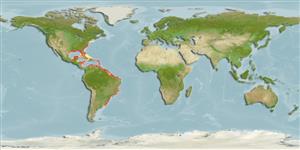>
Carangiformes (Jacks) >
Carangidae (Jacks and pompanos) > Trachinotinae
Etymology: Trachinotus: Greek, trachys, -eia, -ys = rough + Greek,noton = back (Ref. 45335).
More on author: Linnaeus.
Environment: milieu / climate zone / depth range / distribution range
Ecologia
marinhas; estuarina bentopelágico; oceanódromo (Ref. 51243); intervalo de profundidade 1 - 70 m (Ref. 9626). Subtropical; 43°N - 38°S, 97°W - 35°W (Ref. 44847)
Western Atlantic: Massachusetts, USA through the Gulf of Mexico and scattered localities in the West Indies (Ref. 26938) to Brazil. Also found in Argentina (Ref. 44847). Absent from clear waters of Bahamas and similar islands (Ref. 7251).
Comprimento de primeira maturação / Tamanho / Peso / Idade
Maturity: Lm ?, range 25 - ? cm
Max length : 64.0 cm TL macho/indeterminado; (Ref. 7251); common length : 40.0 cm TL macho/indeterminado; (Ref. 5217); peso máx. publicado: 3.8 kg (Ref. 40637); idade máx. registrada: 7 anos (Ref. 125592)
Adults occur in coastal waters, commonly entering bays and estuaries. Juveniles found in sandy beaches exposed to wave action (Ref. 5217). Adults are absent from insular areas with coralline habitats (Ref. 5217). They generally form small to large schools. They feed on mollusks, crustaceans and other invertebrates and small fish. Excellent food fish (Ref. 9626). Highest priced marine food fish in the USA (Ref. 171). Have been reared in captivity (Ref. 35420).
Ciclo de vida ou comportamento de acasalamento
Maturidade | Reprodução | Desova | Ovos | Fecundidade | Larvas
Robins, C.R. and G.C. Ray, 1986. A field guide to Atlantic coast fishes of North America. Houghton Mifflin Company, Boston, U.S.A. 354 p. (Ref. 7251)
Status na Lista Vermelha da UICN (Ref. 130435: Version 2024-1)
Ameaça para os humanos
Harmless
Uso pelos humanos
Pescarias: altamente comercial; Aquacultura: espécies comerciais; peixe esportivo: sim; Aquário: Aquários públicos
Ferramentas
Relatórios especiais
Baixar XML
Fontes da internet
Estimates based on models
Preferred temperature (Ref.
123201): 23.3 - 28, mean 25.6 °C (based on 454 cells).
Índice de diversidade filogenética (Ref.
82804): PD
50 = 0.5000 [Uniqueness, from 0.5 = low to 2.0 = high].
Bayesian length-weight: a=0.01585 (0.00898 - 0.02799), b=2.82 (2.67 - 2.97), in cm total length, based on LWR estimates for this species & Genus-body shape (Ref.
93245).
Nível Trófico (Ref.
69278): 3.5 ±0.6 se; based on diet studies.
Resiliência (Ref.
120179): médio(a), tempo mínimo de duplicação da população 1,4 - 4,4 anos (Assuming tm=2-4).
Fishing Vulnerability (Ref.
59153): Low to moderate vulnerability (27 of 100).
Climate Vulnerability (Ref.
125649): High to very high vulnerability (69 of 100).
Nutrients (Ref.
124155): Calcium = 57.7 [29.8, 115.8] mg/100g; Iron = 0.97 [0.54, 2.04] mg/100g; Protein = 18.8 [16.7, 20.8] %; Omega3 = 0.281 [0.153, 0.553] g/100g; Selenium = 30.8 [15.2, 64.5] μg/100g; VitaminA = 7.89 [2.08, 26.10] μg/100g; Zinc = 0.721 [0.478, 1.101] mg/100g (wet weight);
